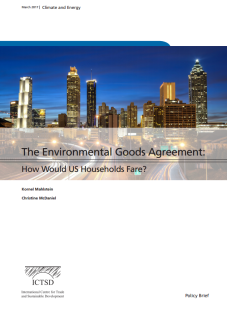
The Environmental Goods Agreement (EGA), initiated in 2014, is intended to reduce tariffs on a list of goods by the signatories, after which concessions will be extended to all WTO members based on the most-favoured-nation principle. While the main objective for reducing tariffs on environmental goods in an accelerated manner is environmental concerns, including the need to address climate change, it also makes good economic sense. Among the benefits are reduced consumer prices for environmental goods. Moreover, EGA tariff elimination can spur the uptake of energy efficient goods, in turn resulting in energy savings.
This paper looks into the case of possible consumer benefits of the EGA in the United States. The authors find that total household savings from the price effect of EGA tariffs cuts overall would amount to roughly $845 million per year, disproportionally benefitting lower-income households. Moreover, the paper estimates that an increased use of energy-efficient light bulbs could save 238 million kilowatt hours, which is equivalent to 124,000 tons of coal each year, or 120% of the greenhouse gas emissions from coal in the state of Maine.
